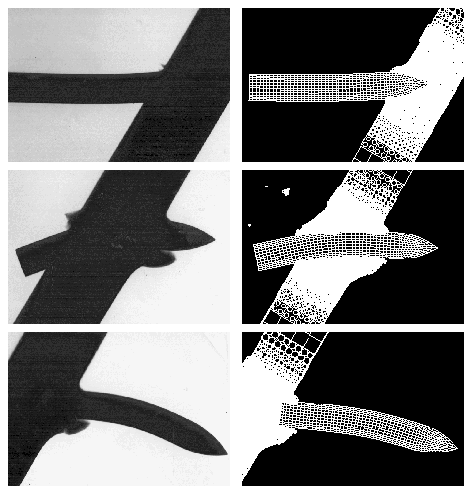
PRONTO is a Sandia transient-dynamics finite-element code that is similar in scope to DYNA-3D or Pam-Crash. It models objects undergoing deformation; prototypical examples are a car crash or the denting/crushing of a shipping container. PRONTO includes a wide variety of material models and a smoothed- particle hydrodynamics (SPH) capability that enables high-strain simulations (e.g. an explosion) that would typically tangle or break conventional finite element meshes.
Here is a cool example of how accurately such codes model reality. The left figures are high-speed photographs of a bullet passing through a metal plate. A PRONTO simulation of the same effect is on the right. Note that the simulation nicely captures the bending and roll-over of the bullet trajectory.

The finite element portion of these calculations can be straightforwardly parallelized. A harder challenge is the so-called "contact detection" problem. When a car bumper impacts the radiator or the bullet touches the plate surface there are additional push-back forces that come into play which must first be detected as mesh overlap. This figure illustrates the kinds of mesh inter- penetration and particle/mesh overlap that must be searched for at every timestep.
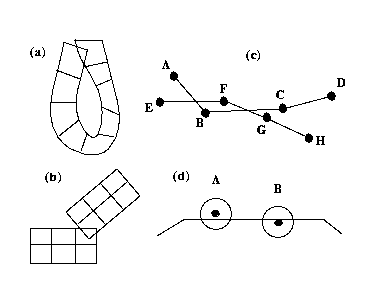
Contact detection has proven difficult to parallelize effectively because it involves a global search across all processors (any 2 processor's elements can overlap) and it dynamically changes as the simulation progresses (elements initially far apart can later overlap). Also it only involves the surface of the 3-d finite element mesh, whereas the mesh is decomposed volumetrically to processors. Hence the search operation can be severely load-imbalanced and require large volumes of communicated data. Consider this idealized container crush simulation where the can folds up in an intricate fashion. When the can is fully crushed, portions of the can surface are touching that initially (in the uncrushed can) were far apart in the mesh topology.
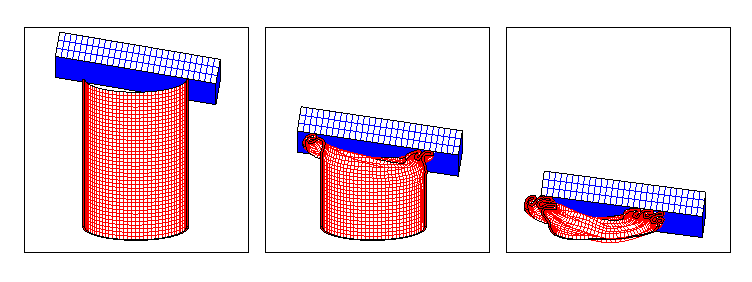
Or consider this simulation of a bar hitting a stack of bricks. As the bricks fly apart, any two bricks (owned by any two or more processors) may come in contact.

Previous parallelization efforts for the contact detection problem generally used a single decomposition of the mesh for both the finite element analysis and the contact detection. They suffered from the load-balance problems described above and typically did not scale to more than a few dozen procesors. In our approach, we use two different decompositions for the two computational steps. We use the standard static, graph-based decomposition for the finite element calculation, and a dynamic, geometric decomposition for the contact detection. Each timestep processors send surface element data (new coordinates) to other processors which own those elements in the geometric decomposition. The surface elements are re-balanced via recursive coordinate bisectioning (RCB) which assigns each processor a compact domain of elements and nodal points. Each processor can then search its local domain (with a bit of overlap with its neighbors) for contacts. The results are shipped back to the processors that own the elements in the finite-element decomposition.
The result is that the two most expensive portions of a PRONTO timestep (finite-elemnt analysis and contact detection) now load-balance independently. There is an overhead cost to ship data back and forth between the two decompositions but it turns out to be small in practice. The resulting code runs scalably on 1000s of processors which has enabled Sandia analysts to run extremely large calculations - tens of millions of elements for long timescales. The code has been optimized for the Intel Tflops machine where it runs at over 100 Gflops on 3000 dual-processor Pentium nodes. This earned the PRONTO work a finalist status for the 1997 Gordon Bell Prize (see paper below) and the gold cup at the 1999 SuParCup competition in Mannheim, Germany.
Here is a result from a calculation of foam struts (a packing material) being compressed between two plates. It involves a considerable amount of contact detection and push-back between the individual struts to model the material response correctly (colors represent the stress state of the material).
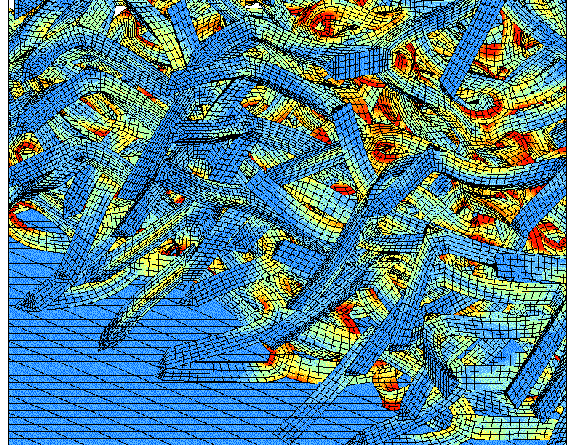
Adding smoothed particle hydrodyanmics (SPH particles) to PRONTO's finite element computations can also pose load-imbalance problems. This is because the particles may only fill a fraction of the simulation domain and they have the same dynamic characteristics as the contact-detection problem. We added a 3rd decomposition to PRONTO to handle SPH particles, so that particle-particle interactions are load-balanced separately, again using the geometric RCB techinque mentioned above.
Here are two examples of coupled finite-element/SPH calculations. In the 1st figure, particles are used to model the earth as a penetrator passes thru. Using a high-resolution finite-element grid for the penetrator, these kinds of simulations can predict the response of small components in the penetrator to a high-velocity impact.
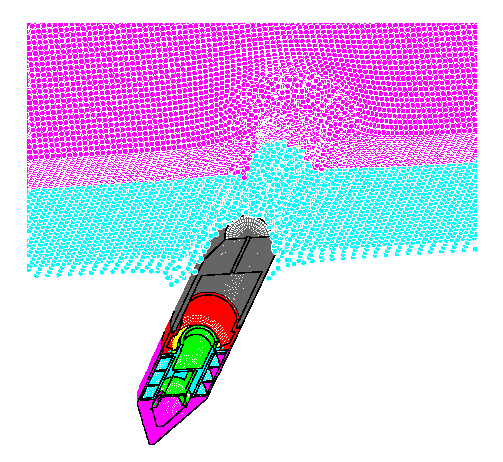
This figure is a simulation of an airplane wing hitting a vertical pole. Fuel dispersal from the torn wing is modeled with SPH particles.
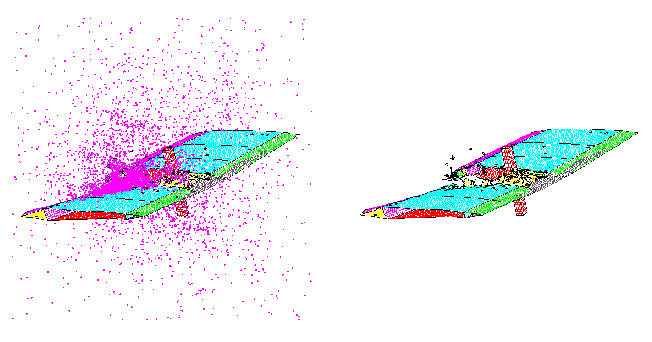
Collaborators on this project:
The following papers describe our parallel contact and parallel SPH algorithms in detail and give an overview of the kinds of simulations PRONTO can perform. They also provide performance results for a few large-scale simulations running on 1000s of processors of the Intel Tflops machine.
Parallel Strategies for Crash and Impact Simulations, K. Brown, S. Attaway, S.J.Plimpton, B. Hendrickson, Computer Methods in Applied Mechanics and Engineering, 184, 375-390 (2000). (abstract)
Parallel Transient Dynamics Simulations: Algorithms for Contact Detection and Smoothed Particle Hydrodynamics, S. J. Plimpton, S. Attaway, B. Hendrickson, J. Swegle, C. Vaughan, D. Gardner, J Parallel and Distributed Computing, 50, 104- 122 (1998). (abstract)
A Parallel Contact Detection Algorithm for Transient Solid Dynamics Simulations Using PRONTO3D, S. W. Attaway, B. A. Hendrickson, S. J. Plimpton, D. R. Gardner, C. T. Vaughan, K. H. Brown, M. W. Heinstein, Computational Mechanics, 22, 143-159 (1998). (abstract)
Transient Solid Dynamics Simulations on the Sandia/Intel Teraflop Computer, S. Attaway, T. Barragy, K. Brown, D. Gardner, B. Hendrickson, S. J. Plimpton, C. Vaughan, Gordon Bell finalist paper, in Proc of SuperComputing '97, San Jose, CA, November 1997. (abstract)
Transient Dynamics Simulations: Parallel Algorithms for Contact Detection and Smoothed Particle Hydrodynamics, S. J. Plimpton, S. Attaway, B. Hendrickson, J. Swegle, C. Vaughan, D. Gardner, in Proc of SuperComputing '96, Pittsburgh, PA, November 1996. (abstract)